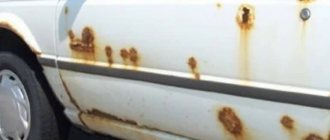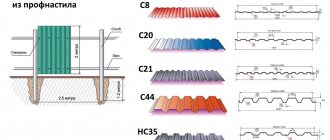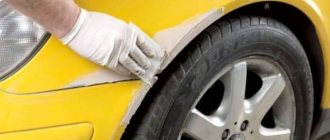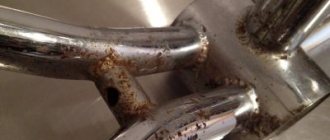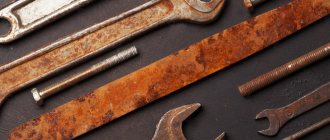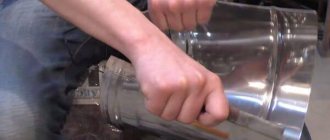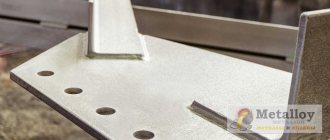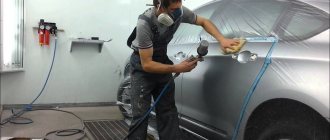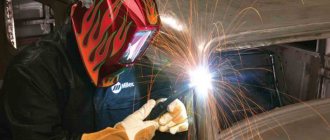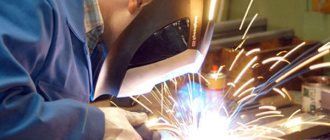The car is rusty - does it happen? “Well, certainly not mine!” – you shake your head. - “Only old rattlesnake rusts!” Sure?!
Alas, this is not true. Any car is subject to corrosion: both the ancient “monsters” of the domestic automobile industry and the very “young” modern foreign cars.
What to do if you unexpectedly find an area of oxidation on the body? First of all, don’t panic - everything can be fixed, and it’s likely that you’ll get by with “little blood” and solve the problem yourself. How to treat rust on a car, how to stop the corrosion process and which product to choose to remove rust from a car – we’ll look at this in this article.
What causes rust?
The classic reason for the appearance of rust is familiar to everyone: chemical reagents, salt solutions and sediments get clogged into chips (available on the body of any car that at least sometimes leaves the garage) and, under the influence of humidity and temperature changes, begin to corrode the metal. This is how the first “bugs” appear - small pockets of corrosion, noticeable only upon detailed examination. However, if you do not attach importance to them, they can soon grow to incredible sizes. And this is the main strength and danger of corrosion - like a cunning enemy, it acts secretly, absorbing more and more new areas of the body. This is why efficiency is so important in the fight against rust: it is always much easier to solve the problem while it is minor; otherwise, after a couple of months of delay, you risk discovering that the process is so advanced that you won’t be able to manage without professional help (=additional financial costs).
1-preparation
- First, the area of the body where rust has appeared must be thoroughly cleaned of dirt . Therefore, before processing, visit a car wash. If it is not possible to completely wash the body, at least rinse and dry the area being treated.
- It is advisable to tape off areas of the body around the work area . Use masking tape to outline the boundaries of your work. To cover the rest of the body, it is better to use a special film for painting the body, and cover the joints with adhesive tape. This will prevent the paint from getting onto other surfaces.
- Choose a suitable day. To ensure that all layers dry properly, it is best to start processing the car on a warm, windless day .
- Decide on a location. You cannot paint a car in an unventilated enclosed area - you may get poisoned. It is better to carry out work outdoors .
- Get equipped. Before carrying out work, put on rubber gloves, goggles, and a mask . If possible, use a respirator. When you start processing, dust from rust, primer, paint will rise into the air - protect your lungs and eyes.
Helpful information:
- Protecting your car from rust: DIY anti-corrosion treatment
- How to remove scratches on a car body with your own hands?
- Do-it-yourself car body polishing
- Protecting your car from salt in winter: we give the reagents a tough fight!
- Arches under the castle: a little about the importance of lockers
- Washing your car in winter: rules of cold cleanliness
You can get professional advice when selecting a product by calling 8 800 555-43-85 (calls within Russia are free).
2-stripping
- It is easier and more convenient to clean the surface using a polishing machine . It will quickly remove rust and is also easy to operate.
- If it is impossible to get the machine, and the damaged area is small, you can use abrasive coarse-grained paper or just sandpaper.
- You need to start processing with a coarser grit (80) and finish with a fine abrasive (150).
- The task of this stage is to remove the layer of paint and primer, reaching the metal of the body, and remove most of the rust. And also - to make the transition from undamaged paintwork to the damaged area smooth.
Which rust repair method is best to choose?
We looked at several ways to remove rust from a car. Regardless of which rust removal method you choose, proper, thorough surface preparation is the key to a successful repair. It is necessary to clean the metal as much as possible from rust, and then apply chemical products to the remaining rust.
Chemicals can be used to remove or transform minor light to moderate surface corrosion. Different remedies may act differently.
All chemicals only delay the spread of corrosion. Light surface corrosion can be permanently eliminated. A guaranteed remedy is to cut out the rusty metal and weld in new one.
In addition to the above remedies, do not forget about acidic (etching) soil. It adheres well to the surface after treating rust with small residues and prevents it from spreading under the paint. It cannot be processed with sanding paper. Immediately after drying, you need to cover it with acrylic primer. Etching primer will not stop medium to thick layers of rust. It contains a small amount of acid, which, first of all, helps improve adhesion to the metal, which eliminates the possibility of slight peeling of the subsequent coating, which reduces the possibility of corrosion. You can read more about the use of acid primer in the article “acid primer for a car.” It can be used together with epoxy primer to ensure that the surface is sealed from oxygen and moisture, but then it is necessary to separate these two primers with acrylic primer, since epoxy neutralizes the action of acidic primer. It turns out to be such a multi-layer “pie”. You can read more about this in the article “acid or epoxy primer, which one to choose.”
After removing or neutralizing the corrosion and sealing the area where the rust was with a special primer, putty is applied to it, leveled and primed. Next, the primer and panel are prepared for painting and painted.
When repairing rust on the front of the panel, do not forget about the back side of the body panel. If possible, you need to check the reverse side, and if there are signs of rust there, take all necessary measures.
So, having figured out how to remove rust from a car, let’s consider what needs to be done to prevent it from appearing again.
4-preparation for painting
- After the rust converter has completely dried, the surface of the metal and paint around it should be gently sanded with fine (120) grit sandpaper.
- Then comes the surface priming stage . Before applying the primer, you need to degrease the surface with solvent or WD-40. The primer is applied according to the instructions, usually 3 layers are enough. You should wait a few minutes between each application.
- Paint is applied only after the primer has completely dried. Usually you have to wait 10-12 hours.
Available means
Each method is specific in its own way. Currently, there is a huge selection of manufactured chemical compounds. You can deal with rust using improvised means that can be found in any home.
Fish oil and baking soda
Fish oil helps to remove corrosion on metal. It should be applied to the problem area and left for several hours. This product helps quickly remove corrosion and creates a thin film on the metal, which will subsequently protect it from the reappearance of rust.
The next remedy is to use baking soda. It must be added to the water in such an amount that the consistency resembles a hair mask. Then the resulting mixture is applied to problem areas and left for 30 minutes. After this, the surface is rubbed with a metal scraper, and if the rust cannot be removed, then this procedure is repeated.
Potatoes and vinegar
When iron is slightly damaged by corrosion, potatoes are used, which helps quickly remove rust. To do this, raw potatoes are cut in half, the fresh cut is sprinkled with rock salt or smeared with laundry soap, after which the rusty area is thoroughly rubbed.
To clean a metal object, mix equal parts acetic acid and lemon juice and apply it to the rust. This product perfectly removes corrosion on metal and red stains on clothes. The exposure time for metal is several hours, and for fabric – about 20 minutes. After this time, the rusty stain on the fabric is wiped with a brush, and on the metal - with steel wool. After removing the rust, the item must be washed.
Citric and oxalic acid
A strong solution of citric acid helps to clean metal from corrosion; for this, take 3 sachets of the product per 1 liter of water.
The resulting liquid must be brought to a boil and the gas must be turned off. Damaged items (bolts, nuts, pliers, screwdrivers, keys, etc.) are placed in the hot solution. The water will immediately begin to bubble. The products must be soaked for at least 8 hours. Softened rust is removed with a sponge or brush. The procedure involving the use of oxalic acid should be carried out in a well-ventilated area
When doing this, you must be especially careful: wear rubber gloves, a gown and safety glasses. If acid gets into your eyes or skin it will cause severe burns.
To prepare a solution to remove corrosion, you need to add 4 tablespoons of acid to a glass of warm water. Before soaking, the metal object is washed with dishwashing detergent and dried. The product should remain in this solution for about 30 minutes. After this, use an old toothbrush to remove rust from the item.
Lime and salt
Acid and salt have a detrimental effect on rust. The citrus must be cut in half and squeezed as much juice as possible onto the rusty areas. Wet areas should be sprinkled with salt on top.
The lime peel should not be thrown away because it will be used as a “sponge” when cleaning off softened rust. After 2 hours, you can try to remove oxidation from the metal. If it does not respond well, then you should wait some more time. Lime can be replaced with lemon, but it will not be as effective.
Thus, to remove rust from metal objects at home, you can use various methods. Any product intended for these purposes is very toxic to both humans and metal
You need to take precautions to avoid accidentally hurting yourself.
Do-it-yourself chemical way to get rid of corrosion
The chemical method differs only in the initial stage - cleaning the part from rust. According to reviews from manufacturers, these substances are able to eradicate rust, stop its further spread and do not damage the iron itself (unlike “sandpaper”). Application is very simple - apply the product to the rusty surface for 30-40 minutes, then wipe with a cloth or rinse with water. But to get a nice, smooth surface you will still have to clean, putty and polish (except for the initial stages of corrosion).
Some funds are available to motorists even with the most modest budget
There are kits on sale that allow you to independently apply a protective layer of zinc to the car body. The kit already contains a solution for removing rust and applying a protective layer, as well as an electrode with a zinc tip. This process is electrochemical, so a connection to a battery is required.
The kit includes liquids and all necessary working tools
Causes and places of rust on a car body
Rust is the oxidation of metal that occurs under the influence of air, water and static electricity. Therefore, the main reason for its occurrence is damage to the paintwork of the car body. Microcracks and physical damage allow air and moisture to reach the iron. The speed of the destructive impact will depend on the degree of protection of the body itself and the aggressiveness of the environment. This is especially true in winter, when many chemicals appear on our roads.
The above factors directly affect the shape, color and depth of corrosion. People call them differently: “saffron milk caps,” “bugs,” or simply “rusty spots,” but their essence is the same (only the degree of neglect varies). A single spot of rust is easier to deal with than many small red spots. The latter usually indicates poor quality metal or unsuccessful body repairs. The total processing area will be larger. Moreover, these points often spread in depth rather than in breadth. Blistering of the paint also signals the need to remove corrosion that has begun to develop under the paintwork.
The most common places for bugs and rust spots (photo)
Thresholds Arches Wings at the arches Trunk
Rust progresses well in places where there is increased exposure to foreign objects: sand, dirt, stones. The hood suffers from small stones from the tires of other cars, the wheel arches from their own “emissions” (by the way, wide non-standard tires or rims contribute to greater damage). The thresholds of the car are also one of the first to rot due to the close proximity to the “aggressive environment”, plus unsuccessful exits from curbs aggravate the situation.
5-painting
- Buy a can of paint that is as close as possible to the color of your car.
- For the best match, find information about the paint shade that was used on your car model's factory paint and select paint from a catalog.
- Before painting, treat the primed surface with fine abrasive (400) sandpaper soaked in water. This will create a flat, smooth surface. Then wash the primer with soapy water and dry.
- Apply the paste in a thin layer, in several approaches .
- Typically the paint takes 24-36 hours to dry.
Main types of corrosion
To determine which methods should be used to treat rust, first of all, you need to understand what types of corrosion exist and how they manifest themselves.
Rust is classified according to several parameters regarding the degree of damage:
- Shallow corrosion stains that spread across the width of the metal surface rather than in depth.
- Small dots that penetrate deeply into a metal product.
- Through corrosion of metal.
- Subfilm type corrosion, in which rust occurs directly under the coating - in such areas, layers of paint usually swell. It is imperative to pay attention to such phenomena in order to prevent the destruction of the metal product.
Main types of corrosion
Popular preparations for removing rust from a car body
You can remove rust from a car body using special automotive chemicals. There are many products on sale that quickly help cope with corrosion of any size and depth. However, they may have varying degrees of effectiveness. Some can completely remove rust completely, others can leave a small amount. Therefore, it is worth considering popular means and studying their features.
Best Liquid Rust Removers
Any liquid corrosion remover must be applied using a roller, brush or any other means at hand. There is a large selection of solvents in stores, so you need to highlight the most popular options.
Loctite 7505 super growth killer
A modern one-component drug, its active substance is a solution of synthetic latex. It turns rust on the car body into a hard black primer - you can apply paint or any other coating to its surface. But before treating with the solution, the surface must be cleaned of old paint, scale, and rust with a scaly structure.
It should be applied in several layers. The drying period for each layer is 1-2 hours. And processing must be carried out at an air temperature of 10-30 degrees Celsius.
Pros:
- Retains basic qualities on surfaces heated to 80 degrees;
- The composition does not contain harmful and toxic components;
- Transforms corrosion and stops its development;
- Quick positive result.
But there is one drawback - the high cost. And all the positive qualities completely justify her.
Neomid 570 professional protect
A concentrated product removes signs of rust from any surface. After applying the drug to affected areas, corrosion is neutralized and transformed into a dense protective film. It improves the degree of adhesion of metal to powder and liquid paint and varnish coatings.
Before application, any remaining paint or rust should be removed from the surface. It should be applied at positive temperatures in several layers. Drying of each layer usually takes 10-30 minutes.
Pros:
- Protects against corrosion for 10 years;
- Suitable for interior and exterior work;
- Does not lose its basic qualities even after 5 freezing cycles;
- Does not include harmful and aggressive components.
The disadvantage is the high price. This is due to the high concentration of the modifier composition.
Rust converter Tsinkar
This is a patented Russian product that helps get rid of rust. It is based on zinc and manganese oxides. After application, it forms a zinc-manganese-phosphate coating on the metal surface. The product is based on two directions of protection - electrochemical and conservation with the application of a protective layer.
Pros:
- Balanced composition and correct ratio of essential substances;
- High efficiency rate;
- At the core there is a combination of factors that destroy rust and protect the metal;
- When used, an alloyed surface is formed.
Minuses:
- Requires thorough rinsing with water;
- The product may damage the paint.
Set for local galvanizing Zinkor
The kit contains liquid solutions for removing grease, removing rust, and applying a protective layer. It is recommended to use as part of the electrochemical method.
Pros:
- High efficiency;
- The kit quickly localizes areas with rust and eliminates them;
- Creates a zinc protective layer using electrolysis.
Minuses:
- The kit includes a very short wire;
- It is not possible to treat hard-to-reach areas.
Professional rust converter Autoprofi galvanization
This is a trigger type atomizer from a Russian manufacturer. The product is placed in a convenient bottle. Its jet is adjustable and you can apply layers of different thicknesses. The composition contains compounds of zinc, manganese and phosphates.
Pros:
- High reliability;
- Quick rust removal;
- After treatment, painting can be done immediately;
- Suitable for hard to reach places and crevices.
The downside is the possible formation of drips from the spray bottle.
Agate auto zincari
A popular rust remover, it is based on zinc and manganese salts. After application, a durable protective film is formed on the surface. Zinc eliminates pockets of electrochemical corrosion, and manganese strengthens the protective coating.
Pros:
- No rinsing required;
- Uniform distribution on the surface;
- Easily gets into hard-to-reach places, hidden cavities, cracks;
- Economical consumption.
Minuses:
- The product cannot penetrate a thick layer of corrosion;
- Before application, the surface is carefully treated.
The best gel rust converters
Gel products can be used in any plane. They can be applied to horizontal, vertical surfaces, and can also be used at an angle. Below are the most popular and effective rust converters in gel form.
Permatex rust treatment 81849
This is a chemical corrosion solvent, recommended for use on steel surfaces. It is based on phosphoric acid. It is recommended to apply with a brush, but residues can be washed off with water.
Pros:
- Has good adhesion on vertical surfaces;
- High quality composition.
But there is a drawback: when used, it can harm the paint.
Kudo ku 70005
The gel is contained in a convenient jar (15 ml), and comes with an additional brush. Recommended for removing rust on ferrous metals. It must be applied twice with an interval of 10-15 minutes. Afterwards, you can apply any paintwork.
Pros:
- Easy application;
- Small and convenient bottle;
- Good penetrating ability;
- Fast and effective results.
Minuses:
- Small volume;
- Suitable for ferrous metals only.
Derusto total gel k2 pro
A professional corrosion remover in the form of a gel. It adheres to surfaces at different angles and does not run off. Has a fast action. Not recommended for galvanized components. It is recommended to apply using a roller or brush.
Pros:
- Quick removal of rust areas;
- Good adhesion at any angle.
The disadvantages include the inability to work with galvanized products.
Top Rust Destroyer in 52
This is a universal gel product that helps quickly get rid of rust on any surface. Before use, the area must be cleaned, and after treatment, paint can be applied.
Pros:
- Versatility;
- Does not spread when applied;
- Economical consumption;
- Affordable price.
Minuses:
- There is an unpleasant odor;
- Needs to be washed off.
The Best Aerosol Rust Converters
In stores you can often find rust removers in the form of sprays or aerosols. They are easy to use and can only be sprayed on corroded areas.
Hi Gear no rust 2x hg5721
This product in the form of a spray is often used in many services to remove rust. It handles small problems, but is also suitable for complex and large jobs.
Pros:
- Easy to use;
- Has a neat and quick effect;
- Uniform distribution;
- Converts corrosion into soil.
The downside is that it requires careful rinsing.
Prevention
To prevent rust from appearing on the body, adhere to the following recommendations:
The car needs to be washed regularly, both in winter and summer. This will remove the aggressive components that are sprinkled on the roads, as well as get rid of dust and dirt, under which the metal quickly collapses.- Anti-gravel film is applied to the hood and roof.
- Mud flaps and fender liners must be installed on each wheel.
- Anti-corrosion treatment of the body must be carried out once every 5 years.
The body should be inspected regularly for rust. When the first signs of corrosion appear, emergency measures are taken.
Requirements for anticorrosives
It is important to understand that rust comes in different forms. Therefore, it is simply necessary to impose increased and strict requirements on anti-corrosion agents. If the anti-corrosion coating of a car does not meet certain parameters, the vehicle owner himself may face unpleasant consequences. The main requirements for anticorrosive agents are the following:
- Environmental friendliness. High-quality formulations from leading manufacturers do not contain components that pose even a potential threat to human health or the environment. This does not mean that you can safely eat mastics. This is absolutely not worth doing. But after applying environmentally friendly anticorrosives, no harm is caused.
- Frost resistance. The climate in each region is varied. In some of them, winter is characterized by extremely low temperatures. Not all anticorrosives can withstand such a load. And since corrosion often manifests its activity in winter due to high humidity and aggressive reagents on the roads, it is impossible to do without protection during this period. Therefore, you need to choose only frost-resistant compounds that can maintain their properties and characteristics even at extremely low temperatures.
- Plasticity and elasticity. If the anticorrosive agent just forms a hard crust after application, you can hardly count on its long service life. The product quickly becomes covered with cracks, gradually begins to collapse, and crumble due to vibrations. High-quality and effective anticorrosives add plasticizers and other components that provide plasticity to the protection.
- Activity. We are talking about the ability of anti-corrosion compounds to actively resist corrosion that has already manifested itself. Some products are extremely effective in terms of prevention, but not all of them cope with already formed areas of metal affected by rust.
- Resistant to abrasives. Dirt, sand, and small stones will constantly hit the metal surfaces of the machine. The bottom suffers especially badly in this case. If the anticorrosive agent is not resistant to minor mechanical damage, its service life after application will be limited to several weeks.
We cannot hide the fact that most formulations from leading manufacturers fully comply with these requirements. But you shouldn’t make hasty conclusions when buying the first anticorrosive agent you come across. First you need to understand their varieties and key features.
3-processing
- After stripping down to metal, the damaged area must be treated with a special agent - a corrosion converter . It will remove small particles of rust, dust and primer and stop the process of metal destruction.
- Rust converters are available in different forms - liquids, aerosols, gels. The operating principle is the same: phosphoric acid in the product interacts with the oxidized surface and creates an airtight film. Thus, the chemical reaction of metal oxidation (rust) stops.
- The product must be applied strictly according to the instructions. Be sure to protect your skin from contact with the drug.
